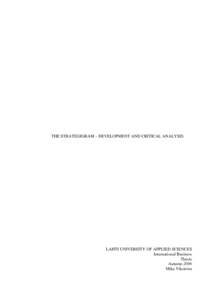| dc.contributor.author | Vikström, Mika | |
| dc.date.accessioned | 2010-03-23T09:09:12Z | |
| dc.date.available | 2010-03-23T09:09:12Z | |
| dc.date.issued | 2006 | |
| dc.identifier.uri | http://www.theseus.fi/handle/10024/11221 | |
| dc.description.abstract | Tämän tutkimuksen tarkoituksena on osallistua Strategigram instrumentin kehittämiseen. Instrumentin kehittäjä International Association of Science Parks:n (IASP) toimitusjohtaja Luis Sanz haluaa luoda uuden tavan analysoida ja tutkia tiede- ja teknologiapuistoja. IASP:n ja Luis Sanzin tarkoituksena on kehittää aiempaa kattavampi metodi, jota voitaisiin soveltaa useimpien tiedepuistojen osalta kaikkialla maailmassa. Strategigramilla voidaan luoda jokaiselle tiedepuistolle oma profiili strategisten suuntausten perusteella. Akseleilla tutkitaan mm. puiston kohdemarkkinoita, kohdeyrityksiä ja erikoistumista. Tämä opinnäytetyö analysoi Strategigramin seitsemää strategista akselia. Metodissa käytetyt indikaattorit ja niiden painotukset analysoidaan rajoitettuun pisteeseen saakka. Tämän opinnäytetyön päätavoitteita ovat ehdotuksien antaminen koskien seitsemää akselia, piilevien vikojen löytäminen, tiedepuistojohtajien mielipiteitten kartoitus ja metodin kehittäminen palveluna IASP:n jäsenpuistoja varten. Tämä opinnäytetyö sisältää pilottitutkimuksen, jonka kohderyhmänä on yksitoista tiede- ja teknologiapuistoa. Tärkeimpiä tiedonlähteitä ovat olleet profiilin luomiseen tähtäävät kyselyt sekä tiedepuistojohtajien haastattelut. Yksi tärkeimmistä analysointitavoista on johtajien omien näkemyksien ja Strategigram-profiilien vertailu. Tutkimuksessa todetaan, että puistot joilla on useampi kuin yksi sijainti tai verkottunut hallintamalli, eivät sovellu sellaisinaan Strategigramiin. Puistoja ehdotetaan tutkittavan vain yksi sijainti kerrallaan ja jokaiselle sijainnille tulisi antaa oma profiilinsa. Kohdeyritysakselilla todetaan, että instrumentti ei huomioi nuoria teknologiapainotteisia yrityksiä, jotka eivät kuulu yhteenkään yrityshautomoon. Tutkimuksessa suositellaan indikaattoria, joka ottaisi huomioon nämä nuoret yritykset. Kohdemarkkina-akselilla suositellaan, että akselin pitäisi pohjautua enemmän puiston todelliseen tilaan kuin tavoitteisiin. Niille akseleille, joilla ei ole suuria vikoja, ehdotetaan pieniä muutoksia painotuksiin. | fi |
| dc.description.abstract | This study participates to the development process of an instrument called Strategigram. The creator of this instrument - the General Manager of the International Association of Science Parks (IASP), Luis Sanz - wants to create a new and more comprehensive way to analyse and examine science parks. The IASP and Luis Sanz aim at developing a method that is at the same time - unlike the prior research - applicable around the world, to a number of science park models and includes more than just one or two elements. The Strategigram examines different strategic approaches and creates each science park a profile with respect to such strategic issues as the target markets, target companies and the degree of specialisation. This study examines seven strategic axes of the Strategigram. The indicators and weights used on each respective axis are examined to a limited degree. The main objectives of this work are to give proposals concerning the seven axes, detect latent defects, study perceptions of the science park managers and to come up with improvement proposals concerning the Strategigram as a service for the member parks of the IASP. A pilot test of eleven science parks is conducted. The primary sources of information in this study include questionnaires - used mainly for creating a profile for each park - and interviews of the science park managers. One of the main analyses used in this work is comparing the selfperceptions of the science park managers to the Strategigram profiles. It is found out that multi-site science parks and networked management models do not fit the Strategigram as such. It is recommended that each site of the park should be examined alone and given its own profile. On the Target Companies axis, it is found out that the instrument does not take into account New Technology Based Firms that are not part of any incubator. An indicator that takes into account these companies is recommended to be added to the criteria. On the Target Markets axis, it is recommended that the axis should reflect more the present state of the park instead of the objectives of the park. In addition, Minor changes to the weights of those axes that do not pose any bigger problems are recommended. | en |
| dc.language.iso | fin | |
| dc.publisher | Lahden ammattikorkeakoulu | |
| dc.rights | All rights reserved | |
| dc.title | The strategigram | fi |
| dc.type.ontasot | fi=AMK-opinnäytetyö|sv=YH-examensarbete|en=Bachelor's thesis| | |
| dc.identifier.dscollection | 10024/302 | |
| dc.organization | Lahden ammattikorkeakoulu | |
| dc.contributor.organization | Lahden ammattikorkeakoulu | |
| dc.subject.keyword | teknologiayritykset | |
| dc.subject.keyword | yrityshautomot | |
| dc.subject.keyword | science parks heleco | |
| dc.subject.specialization | Liiketalouden koulutusohjelma | |
| dc.subject.degreeprogram | fi=Liiketalous, hallinto ja markkinointi|sv=Företagsekonomi, förvaltning och marknadsföring|en=Business Management, Administration and Marketing| | |
| dc.subject.discipline | Liiketalouden laitos | |
